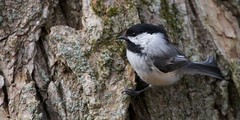From sunrise to sunset, the chickadee spends most of its time feeding. The natural diet of the Black-capped Chickadee consists of 50% insects, insect eggs, larvae and pupae, as well as spiders, and 50% seeds and berries in the winter. During the summer it is 70% bugs and 30% plants.
Chickadees eat lots of weed seeds like milkweed, goldenrods and ragweeds. Seeds that remain uncovered in the winter snows like rushes, conifer seeds, and cattails can also be very important to survival. Some of their favorite berries include poison ivy and bayberry.
.
Suet or animal fat also provides lots of calories to produce energy in cold weather. You can offer suet that is rendered into suet cakes but chickadees can also find suet naturally from a dead deer or any other animal that has been opened up by scavengers.
Mid-Michigan's chickadees are non-migratory and will be around all winter. New fall and winter flocks have been forming for awhile. Flocks can consist of 2 to 18 birds. Normal suburban flocks range from 6 to 10 birds over a territory of 20 to 50 acres.
Young chickadees leave their parents about a month after they’ve hatched. They leave their natal territory and individually take up residence with other non-related chickadees several miles away. These first year chickadees have the lowest status in the group and try to pair up with a mate they can be with next breeding season and move up in rank as dominant birds die.
The average lifespan of a chickadee in the wild is 2.5 years. Keeping their little half ounce body working efficiently requires a lot of fuel. And the worse the conditions the more the chickadees need to eat.
Inquisitive, energetic, and strikingly marked, the Black-capped Chickadee is regular visitor to Michigan feeders especially in the fall. They may seem to be in a little bit of a frenzy. Attracted to sunflower seeds, peanuts, and suets at a bird feeding station, they are collecting food and hiding it for later just like squirrels. Click HERE to read more on how chickadees cache their food.
References and More Information:
Category ›
Quick fun Facts
 Unknown
Unknown
 Sunday, September 12, 2010
Sunday, September 12, 2010











No comments:
Post a Comment